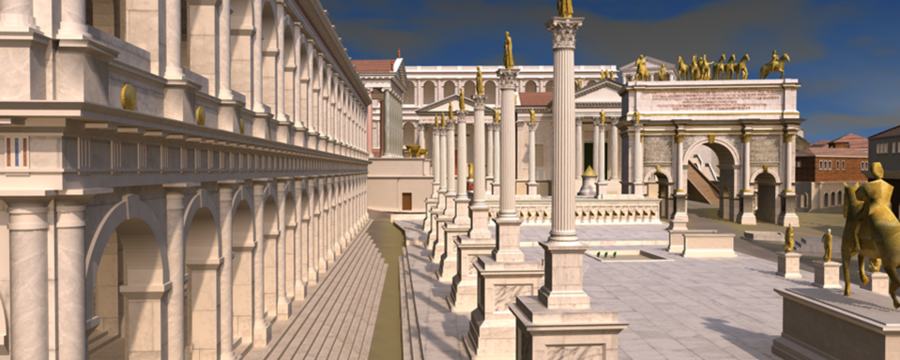Ancient Rome: a historical overview

Share this step
The passage by the Roman historian Livy praising the site of Rome is put into a speech by a general called Marcus Furius Camillus:
Not without reason did gods and men choose this spot for the founding of our city—the healthy hills, the convenient river by which produce from the inland regions could be brought in, and sea-borne commerce received; the sea itself, near enough for convenience but not exposed by too great proximity to the danger of foreign fleets; our location in the middle of Italy—all these advantages make it of all places in the world the best for a city destined to grow great.Livy, 5.54.
Figure 1: Map of the Italian Peninsula around 400 BC. © Map adapted from image via Wikimedia Commons under licenseCC BY-SA 3.0
… they came to the house of humble Evander, and saw cattle here and there, mooing where the Roman Forum and the fashionable Carinae district would be.Virgil, Aeneid VIII.359-61.
… for the adornment and improvement of the city, and also for the protection and extension of the Empire, he planned more and greater projects every day: first of all, to construct a temple of Mars, greater than any in existence, filling up and levelling the lake in which he had put on the spectacle of a mock sea-battle, and to build a theatre of enormous size, sloping down from the Tarpeian rock; … to make public the greatest possible libraries of Greek and Latin books … to drain the Pomptine marshes; to let out the water from Lake Fucinus; to make a highway from the Adriatic Sea across the spine of the Apennine mountains as far as the Tiber; to cut a canal through the Isthmus of Corinth; … death cut him off as he was doing or planning such things.Suetonius, Life of Caesar 44.
… since the city was not adorned in proportion to the dignity of the empire, and was ruined by floods and fires …[Augustus] so beautified it that he could justly boast that he had left in marble that which he had found in brick.Suetonius, Life of Augustus 28.
I built the senate house and the chalcidicum next to it, the temple of Apollo on the Palatine with its porticoes, the temple of the deified Julius Caesar, the Lupercal, the portico at the Circus Flaminius which I allowed to be called the ‘Octavia’ after the man who had constructed an earlier one on the same site, the imperial box at the Circus Maximus, the temples on the Capitol of Jupiter Feretrius and Jupiter the Thunderer, the temple of Quirinus, the temples of Minerva, of Juno the Queen, and of Jupiter Libertas on the Aventine, the temple of the Lares at the highest point of the Sacred Way, the temple of the Di Penates on the Velia, the temple of Iuventus, and the temple of Magna Mater on the Palatine. I rebuilt the Capitol and the Theatre of Pompey, both works of great expense, without any inscription of my own name. I rebuilt the channels of the aqueducts, which had in several places subsided through age, and I doubled the aqueduct called the Marcia by adding a new source to its channel. I completed the Forum Iulium and the basilica between the temple of Saturn and the temple of Castor and Pollux, works begun and almost completed by my father. When the same basilica was destroyed by fire I began its reconstruction on an enlarged site under the name of my sons and, if I should not live to complete it, I ordered that it should be completed by my heirs. As consul for the sixth time, in accordance with a decree of the senate, I rebuilt eighty-two temples in the city, with none omitted which at that time needed to be rebuilt. As consul for the seventh time, I made the Via Flaminia from the city to Rimini, and all the bridges except the Mulvian and Minucian. On private ground I built the temple of Mars Ultor and the Forum Augustum, from the spoils of war. I built the theatre near the temple of Apollo under the name of my nephew Marcellus, on ground bought for the most part from private owners.Res Gestae Divi Augusti, 19-21.
This impressive list includes many of the types of building that you’ll see on this course: infrastructural works such as roads and aqueducts; religious buildings; buildings for politics and state functions like basilicas and forums; and buildings for entertainment like theatres and the Circus Maximus. In his efforts to build in the city, honouring its gods and keeping its people fed, watered, and entertained – and then ensuring through this inscription that he got as much credit as possible – Augustus (as we shall see) set a pattern that was widely followed by later emperors.
Update: 20 October
Figure 1 has been updated with the correct spelling of Carthaginians.
Share this
Rome: A Virtual Tour of the Ancient City


Reach your personal and professional goals
Unlock access to hundreds of expert online courses and degrees from top universities and educators to gain accredited qualifications and professional CV-building certificates.
Join over 18 million learners to launch, switch or build upon your career, all at your own pace, across a wide range of topic areas.
Register to receive updates
-
Create an account to receive our newsletter, course recommendations and promotions.
Register for free







